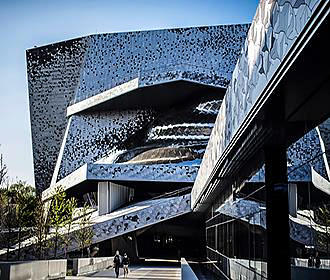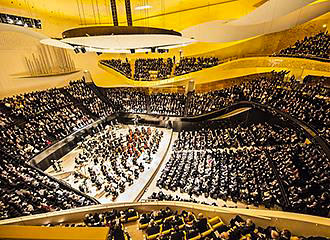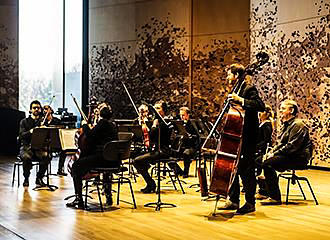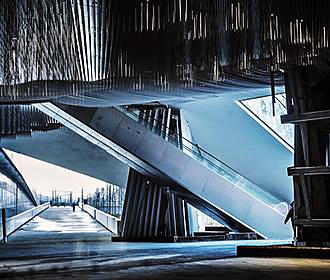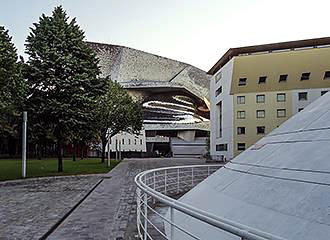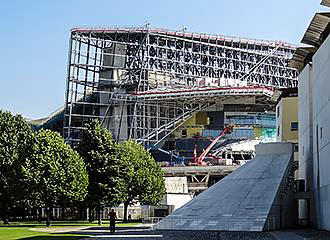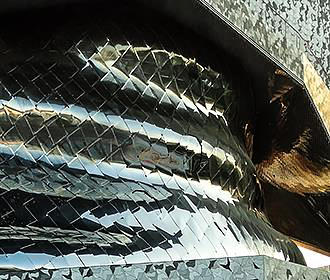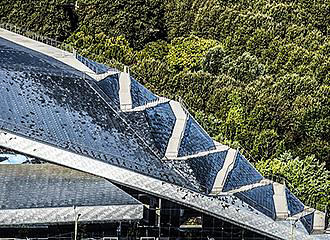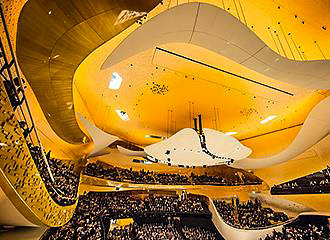Philharmonie de Paris Concert Hall in Parc de la Villette
Located within the Parc de la Villette park, the Philharmonie de Paris is the new and very large concert hall within this major cultural area of Paris, which is already home to the Cite des Sciences and the Cite de la Musique with the Musee de Musique Museum plus many other cultural and entertainment venues.
About the project for the Philharmonie de Paris
This project was a joint undertaking between the French government and the city of Paris and the idea was to construct a major new music complex in order to become the home of the Orchestre de Paris, which was resident within the Salle Pleyel concert hall in Paris.
An international competition was launched and eventually six proposals were shortlisted and these finalists competed for the construction project management. Eventually after the different proposals were presented with models and videos at the Cite de la Musique, the overall winner was the Ateliers Jean Nouvel company, which was first founded by Jean Nouvel back in 1970, and has become one of the largest architectural firms in France.
The construction site for the new Philharmonie de Paris Concert Hall was chosen to be within the Parc de la Villette opposite the Grande Halle, which was the original cattle market built in the 1800s and is now classified as a historical monument in Paris. It is also adjacent to the Cite de la Musique on an area that was originally used purely for parking and covers an area of almost 20,000 metres squared.
The project is centred around a 2,400 seat symphonic concert hall, which meets the demands of international standards with its acoustics and Jean Nouvel joined forces with Harold Marshall to accomplish this task.
Yet the design of the Philharmonie de Paris Concert Hall in Parc de la Villette is completely different to the classic style where the audience would be directly in front of the musicians, as it takes on a completely different approach, by engaging the audience even further with the performers, by having the seating arranged all the way round the stage.
And even though the Philharmonie de Paris Concert Hall is designed primarily to host major symphony orchestras from around the world, with the Paris Orchestra becoming a resident, the Philharmonie de Paris will also promote many other forms of music such as Jazz and other types of music from all over the world.
But in addition to the main concert hall, which has a very modern and unique design, you will of course have the usual foyers and rehearsal rooms along with administration and technical rooms. Yet there is also an educational wing where children and adults can learn about music along with exhibition spaces, a cafe and a restaurant called Le Balcon.
Also, a very positive approach has been given to make this concert venue accessible to all, including the disabled, and they offer every visitor a personalised welcome, to make this more inviting, even to the younger generation.
The vision of Jean Nouvel was to make the Philharmonie de Paris look and feel like a hill where you could view some of the city, which is a height of 52 metres and although the concert venue was originally due to open its doors to the public for the first time in 2014, it did not eventually open until January 2015 and became linked with the Cite de la Musique.
The design of the Philharmonie de Paris today
Jean Nouvel wanted to created a modern and unique design for new concert hall that would complement the cultural visions of the Parc de la Villette and the designs of the Cite de la Musique by Christian de Portzamparc, which is also home to the impressive Musee de la Musique, along with the design of the Folies by Bernard Tschumi.
There are innovative spiralling aluminium forms that surround the central concert hall that provide a contrast to the exterior angled matt coated sides of the Philharmonie de Paris that was designed to look like a mound, or a hill.
The Philharmonie de Paris Concert Hall exterior was coated with a bird mosaic utilising different shades of grey, many of which, make the building shimmer against the sky. Incredibly there were 340,000 birds, made of aluminium and in seven different shapes with four different colours of grey that were place on the facades of this Paris concert hall.
On one side of the 52 metre high building facing towards the Tramway and the Boulevard Peripherique, which is the ring road that goes round Paris, there is a large luminous wall screen that announces upcoming events at this concert venue.
Yet it was also envisioned in such a way that people could not only enjoy the interior and a concert, but also experience the outside and panoramic views, which is exactly what happened as there is a viewing area on the roof of the Philharmonie de Paris at a height of 37 metres, which provides views over the north eastern part of Paris and its suburbs.
You will find that there are lifts, or elevators, located at the front of the main hall, which will whisk you up to the 9th floor where you exit onto a vast plateau located on a part of the roof. From here you can enjoy views looking towards many of the popular Paris tourist attractions in the distance, which include the Montparnasse Tower, the famous landmark of the Eiffel Tower, even Sacre Coeur Basilica in the Montmartre area, the Stade de France and many more.
When you decide to come down from the roof, you can utilise the lifts, however, there is also, what is referred to as a mountain path, which winds its way down on the northern side of the Philharmonie de Paris to a grass area of the Parc de la Villette.
As for the inside, the Philharmonie de Paris was designed with state of the art technology and a facility for the Orchestre de Paris, which provides a unique space able to welcome international symphonic and philharmonic orchestras from around the world, which has a concert hall that can cater for up to 2,400 people.
The Symphonic Hall, known as the Grande Salle Pierre Boulez located within the Philharmonie de Paris, is unique its design and was a collaboration between the architect Jean Nouvel and lead acoustician Sir Harold Marshall, which does not follow the shoebox style like the Musikverein in Vienna, nor the vineyard style of the Berlin Philharmonie.
In fact, the original design required innovations in architecture, stage design and acoustical engineering, which means that even though it is a large capacity hall, it still feels a more intimate space than many. You will find that the maximum distance between the conductor and the furthest away spectator is only 32 metres, compared to the Salle Pleyel where you could be up to 48 metres away, even though it is a smaller concert venue in Paris.
Within the Symphonic Hall you will find that there are cantilevered balconies that feel like they are floating and the outer chamber achieves the high reverberation required to achieve excellent clarity with a warm enveloping resonance, plus it is soundproofed from outside noise by incorporating a gap between two set of walls that surround the concert hall.
When it comes to the stage, this can accommodate any type of orchestra formation including the largest and most imposing and Jean Nouvel worked closely with Agency Ducks who specialise in concert hall stage design, so that it could accommodate a wide variety of different types of music.
There are tiers behind the stage that normally have seating for spectators, yet these can be utilised for a large choir, removed for Opera style concerts, so that the stage can move back and the parterre can be increased, or alternatively it can be for standing room during a contemporary music concert, so hence the innovative design goes far beyond the exterior.
Philharmonie de Paris Some Key Facts
Upon its opening in 2015, the Philharmonie de Paris merged with the Cite de la Musique that was opened within the Parc de la Villette 20 years prior, and although they are two separate buildings, they work together under an institution named Cite de la Musique - Philharmonie de Paris, to provide opportunities for students, workshops, practise rooms, an information and resource centre, plus a very varied programme along with the impressive Musee de la Musique for the public.
Combining the two places, including the impressive 2,400 seat symphonic concert hall of the Philharmonie de Paris, there are now three different concert halls equating to a total of 3,603 seats, and two organs, which have a combined total of 8,390 tubes, not forgetting there are now 18 different rehearsal spaces.
On top of that, where we mentioned earlier that the Orchestre de Paris has taken up residence at the Philharmonie de Paris rather than the Salle Pleyel, there are also four other resident orchestras, which are the Orchestre National d'Ile de France, the Orchestre de Chambre de Paris, the Ensemble Intercontemporain and Les Arts Flurissants, plus they play host to international philharmonic orchestras.
There are also 24 different educational spaces located within the Philharmonie de Paris and the Cite de la Musique, which have a total of around 5,000 different instruments combined, plus there is also a conference room. Not forgetting that there is a media library with absolutely 1000s of resources and full concerts, recordings, etc, which are available for people to discover more on a particular subject that interests them.
Visiting the Philharmonie de Paris Concert Hall
Incredibly, in just one season, the Philharmonie organises well over 400 different concerts with approximately 40 percent being Symphonic Repertory, although other concerts are made up of Jazz, World Music, Baroque, Chamber Music, Contemporary Music, Recitals and Educational Concerts, so there is always something for everyone's tastes.
With well over 600,000 tickets sold each season, they vary greatly in cost depending upon the hall and the configuration, plus what you wish to experience and where you will be seated, but to give you an idea, these could be from around €15 up to around €160 as of 2018.
However, if there are any unsold tickets for one of the concerts, not including children's shows or family concerts, and you are aged below 28 or over the age of 65, then on a first come first served basis, these are given out at a discounted rate, 30 minutes prior to the concert starting. These are only €20 for a category 1 ticket that would normally cost between €40 and €70 and only €30 for category 1 ticket that would normally cost anything from €70 up to around €160.
There are also themed weekends where you can experience a specific genre of music for instance, plus there are always temporary exhibitions organised, all around the theme of music, but often including photography and other art forms to provide a complete picture.
Within the Philharmonie de Paris in the main foyer on the ground level you will find there is a bookshop and gift shop providing a large selection of books, CDs and DVDs from virtually every musical genre you could think of, not forgetting gifts and souvenirs, exhibition catalogues and a dedicated children's section, which is open during all exhibitions and events.
When there is an event at the Grande Salle Pierre Boulez, which as we mentioned earlier, is the Symphonic Hall, you will find that there is a gift shop located on level 3 that is open before and after a show, plus during the intermission.
For those of you that wish to have a relaxing break, enjoy a coffee or even a complete meal, you have a cafe located under the portico of the Cite de la Musique along with the Cafe des Concerts.
However, there is also a gourmet restaurant called Le Balcon, which has been designed as an informal contemporary bistro, that is located on level 6 of the Philharmonie de Paris with panoramic views and a very tempting a la carte menu. Plus it has a licensed bar with a great variety of wines that can be purchased by the glass or by the bottle.
Access to the Philharmonie de Paris
You will find that the Philharmonie de Paris is open on a Tuesday to Friday from noon until 6pm and on a Saturday and Sunday from 10am through to 6pm, yet it is open later on days when concerts are being held.
If you wish to experience the panoramic views of the Philharmonie de Paris from its roof top terrace, you will find that this is open to the public on a Wednesday through to a Sunday from noon until dusk, so closing times do vary throughout the year and the lifts can only be accessed during the opening times of concert hall that we mentioned above. However, we would like to point out that this can be closed for safety reasons, like if there are adverse weather conditions such as high winds.
For those of you who have been to see an evening concert scheduled for 8:30pm in either the Grande Salle Pierre Boulez, Symphonic Hall at the Philharmonie de Paris or the Salle des Concerts, Concert Hall at the Cite de la Musique, then upon showing your ticket for the concert, you can utilise the post concert free Shuttle service, with two different routes that will get you back to the heart of Paris.
Both leave from the Porte de Pantin and the first shuttle stops at places such as Republique, Gare de l'Est, Hotel de Ville, which is the City Hall, Saint-Michel and finishes at Denfert-Rochereau. The second shuttle makes stops at the Gare du Nord, the Gare Saint-Lazare and finishes at the Charles de Gaulle-Etoile by the Arc de Triomphe.
Now when it comes to Paris public transport, you will find that the nearest Metro station is the Porte de Pantin stop serving Line 5, which is located at the southern end of the park close to Cite de la Musique and the Grande Halle.
There is also the Tramway serving Line T3B located close by, plus the Paris bus lines 75, 139, 150, 151, 152 and 330 along with the Noctilien Night Bus Service via Lines N13, N41, N42, N45 and N140 will also get you within walking distance of the Parc de la Villette and the Philharmonie de Paris, although the Bus Lines 75 and 151 are the closest. However, there is also a Velib station for the self service bike hire located next to the park at the Avenue Jean Jaures.
Plus there are several different public car parks with 24 hour surveillance that you can utilise if you have your own vehicle. One of these is located under the Cite de la Musique, however, there is another called Q-Park Philharmonie, which is located underneath the Philharmonie de Paris and has direct access to this concert venue. Although do bear in mind that there are height restrictions on these, yet they do have dedicated disabled spaces as well.
In addition to these options, you could always enjoy a canal cruise, or even rent your own boat on the canal, and one company offering cruises and even a shuttle service during the summer months is Canauxrama. Yet there is also another called Paris Canal that leaves from a dock by the Musee d'Orsay in the heart of Paris for a cruise that take you close the Parc de la Villette.
